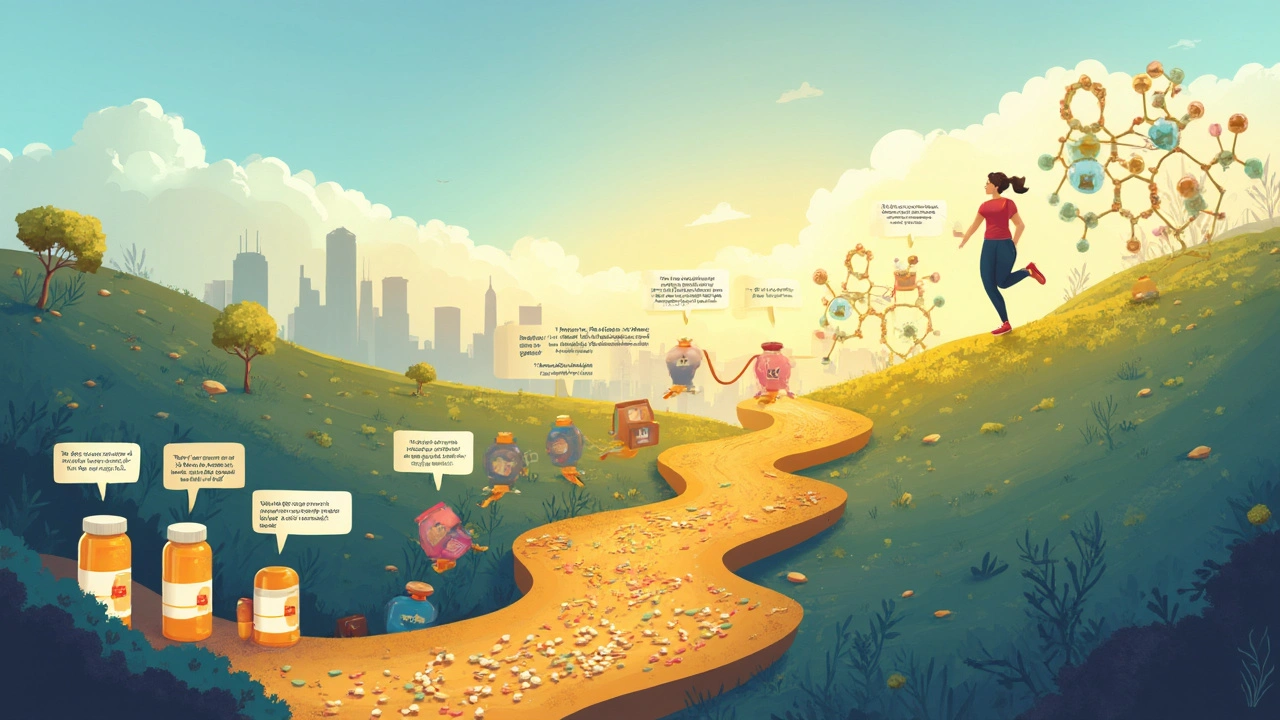
Picture being stuck on steroids for months, maybe years, because of an immune system that just won't quit. You start to get puffy, your blood sugar goes wild, and doctors keep warning that your bones might turn to powder. Now, there’s buzz about new drugs—biologics promising better control with fewer side effects. But the big question stays the same: are they really worth the cost?
How Biologic Therapies Replace Steroids: Real Science and Surprising Results
Steroids like prednisone have been the go-to for things like rheumatoid arthritis, Crohn’s, and lupus for decades. They crank down inflammation, but the side effect list seems endless: weight gain, insomnia, infection risks, brittle bones, insane hunger. That’s why biologics—specifically TNF blockers, IL-6 inhibitors, and JAK inhibitors—showed up like the new kids in town, carrying hope and sky-high expectations.
Let’s look at how they work. TNF blockers shut down tumor necrosis factor, a troublemaker molecule behind chronic inflammation. Popular options—like etanercept (Enbrel) or adalimumab (Humira)—are weekly injections or infusions. IL-6 inhibitors, such as tocilizumab (Actemra), block a different inflammatory signal. Then you have JAK inhibitors (think tofacitinib/Xeljanz and baricitinib/Olumiant), which come as pills, finally giving people a break from needles. These drugs are much more targeted than steroids, and theoretically, that means fewer unwanted side effects.
And here’s a fun fact: some patients who switched from prednisone to biologics say their quality of life feels almost "normal" again. Less brain fog, better sleep, not having to monitor their blood sugar around the clock. But here’s where things get tricky—these benefits aren’t uniform for everyone, and no doctor can predict who’s going to be the next “success story.”
Take a peek at some real data comparing effectiveness and side effects from reliable clinical studies published up till 2024:
| Drug Type | Common Brand | How It Works | Side Effects | Percent Achieving Disease Remission (12 months) |
|---|---|---|---|---|
| TNF Blocker | Humira | Targets TNF molecule | Infection risk, injection site pain | 40-50% |
| IL-6 Inhibitor | Actemra | Blocks IL-6 signaling | Liver test changes, infection, GI issues | 30-45% |
| JAK Inhibitor | Xeljanz | Inhibits JAK pathway | Blood clots, infection, cholesterol changes | 35-48% |
| Steroid (for comparison) | Prednisone | Suppresses immune system broadly | Bone loss, weight gain, diabetes, mood changes | 35-40% |
Read that closely: these new meds aren’t a slam dunk for everyone. They still come with their own risks—some people get infections, some get weird liver tests, a rare few wind up hospitalized from side effects. The differences aren’t always as big as pharma ads might have you believe.
You may not realize this, but biologics don’t flip the off switch for all symptoms. Some users still need a sprinkle of steroids to keep flares at bay, especially early in the treatment game. Others get such good remission that they can ditch prednisone completely—big win in their book. The truth? Only careful, trial-and-error swapping (with your doctor guiding you closely) really gives answers. And for every "miracle story" online, you’ll read someone who needed to go right back to steroids.
Don’t forget pricing. Biologics regularly land in the $2,500–$4,000 per month range before insurance, and that doesn’t even factor in dose changes or doctor monitoring. In the US, insurance is finicky—co-pays might be $50 or $500 depending on your plan. In socialized medicine countries, you might wait ages on a list. Steroids, by contrast, cost so little you’ll pay with pocket change.
And if you’re curious about other treatments that claim to be alternatives, check out this full breakdown on what's currently available, what actually works, and what key risks to avoid by following this alternative to prednisone guide.

The Real Costs: Money, Time, and the Risk Factor Nobody Talks About
Here’s a question nobody likes to answer: if a treatment costs thousands every month but only works for some, who’s really paying for the promise? Biologics sound dreamy, but the price can flatten your wallet if you don’t have bulletproof insurance. Even with coverage, red tape and prior authorization headaches are a regular grind—just ask anyone who's had to chase paperwork for a refill while their symptoms are ticking upward.
But let’s talk about hidden costs. With steroids, you might pay for the meds, but the real price comes later: dental work for crumbling teeth, Dexa scans for bone checks, long-term diabetes meds, surgery for cataracts. With biologics, the sticker shock hits up front, but if they work, you might dodge years of doctor visits and side effects recovery.
Something else gets left out of most brochures: the wait time to see benefits. While a steroid can crash through inflammation in days, biologics are often a slow burn—sometimes you wait three to six months before you know if you’ve got the right one. Meanwhile, you might be juggling both drugs (and all those side effects). Switching between biologics is another slog. Doctors usually need to fill out "treatment failure" paperwork to justify each switch, which can delay relief by weeks.
Here’s a wild stat: research from The Lancet Rheumatology in late 2023 found that up to 52% of people who start a biologic switch or discontinue it within the first year. That’s half the patients—so you’re far from alone if you end up playing musical chairs with your meds.
Then there’s the risk factor nobody loves to discuss: rare but serious events. TNF blockers can bump your risk for tuberculosis, and JAK inhibitors recently flashed some red safety flags after links to blood clots and heart complications emerged. It’s not common, but when you move from "statistical risk" to "it happened to me," the conversation gets way more real.
A table can help show this trade-off in numbers:
| Therapy | Upfront Monthly Cost (USD) | Average Onset to Effect (weeks) | Serious Infection Rate (%) | Long-term Disability Prevention |
|---|---|---|---|---|
| TNF Blocker | $3,200 | 4-12 | 2-4 | Good with long-term use |
| IL-6 Inhibitor | $2,900 | 4-8 | 3-6 | Moderate; varies by patient |
| JAK Inhibitor | $2,700 | 2-8 | 4-7 | Good—caveats for high clot risk |
| Steroid | $30 | 1-3 | 6-10 | Poor—due to side effect baggage |
So you’ve got a treatment that’s fast and cheap, but rough on your body, versus a slower, pricier one with different (sometimes sneaky) risks. For anyone with a chronic inflammatory disease, it’s all about weighing what you can tolerate now versus what you hope to avoid down the line.
Quick tips for folks thinking about making the switch:
- Ask your doctor directly about out-of-pocket costs—not just the drug, but labs and visits.
- Push for infection screening and regular monitoring. TB and hepatitis can be deadly if reactivated.
- If you travel a lot, know that some biologics need refrigeration and strict timing for doses.
- Don’t be shy about insurance appeals—coverage is a moving target and “no” can easily turn into “yes” with persistence.
- Keep a symptom and side effect tracker—it helps spot patterns and makes doctor visits more productive.

Beyond the Hype: What to Expect If You Swap Steroids for Biologics
Let’s cut through the marketing. Steroids are quick, they’re dirty, and for all the misery, they do what needs to be done—especially in flares. But no smart doc recommends sticking with them forever. Biologics dangle the carrot: targeted relief, with less wreckage to the rest of you. Yet some patients swap one set of worries for another.
Maybe you’re picturing a life where you pop a JAK inhibitor pill before coffee and forget you’re even sick. Sometimes, that does happen—some studies done by groups like the American College of Rheumatology show that a third of patients reach “deep remission” on biologics alone. But many others need combo therapy, meaning a little steroid or methotrexate stays in the picture.
What you should actually expect? If you’re shifting from steroids to something like a TNF blocker or JAK inhibitor, you’ll likely start both at once, then try to taper the steroid after a few weeks or months. The difference in mood and sleep can be pretty wild—steroid withdrawal is real—and this process needs to be slow and steady. Don’t be surprised if you face setbacks and the plan gets tweaked along the way.
There’s practical stuff too: TNF blockers are usually injections. You either poke yourself at home or find a nurse to help—think EpiPen, but more routine. IL-6 inhibitors might need monthly infusions at a clinic, and that can be tough for anyone with a packed schedule. JAK inhibitors are the simplest to take (just pills) but their monitoring requirements are anything but simple. Blood counts, liver tests, cholesterol—bring on the lab work.
If you’re hoping to avoid side effects, keep your expectations in check. Yes, you could dodge diabetes and osteoporosis, but you do trade off for things like shingles outbreaks, fatty liver, or small rises in certain cancer risks over time. Nobody gets a free ride; it's all about what you're willing to risk to gain.
One more thing you won’t read on most pharma websites: peer support matters. The internet is full of communities where patients swap tips like how to minimize injection pain, or which days of the week are best for infusions so you don’t miss work. Don’t underestimate how helpful those tricks can be in day-to-day life.
If you want to dig even deeper into what works, what doesn’t, and how you might get symptom relief without diving into the unpredictable world of steroids, the article on alternative to prednisone lays it out—with a no-nonsense look at both prescription and non-prescription options.
Bottom line? Biologics aren’t miracle cures, but for people who just can’t handle one more day of steroid side effects, they really do shift the playing field. If you’re one of the lucky ones who hits remission, you’ll say they’re worth every penny. But that price tag, the wait for results, insurance drama, and unexpected risks mean you’ll want to go in with your eyes wide open and your expectations set somewhere between “hype” and “hard truth.”




